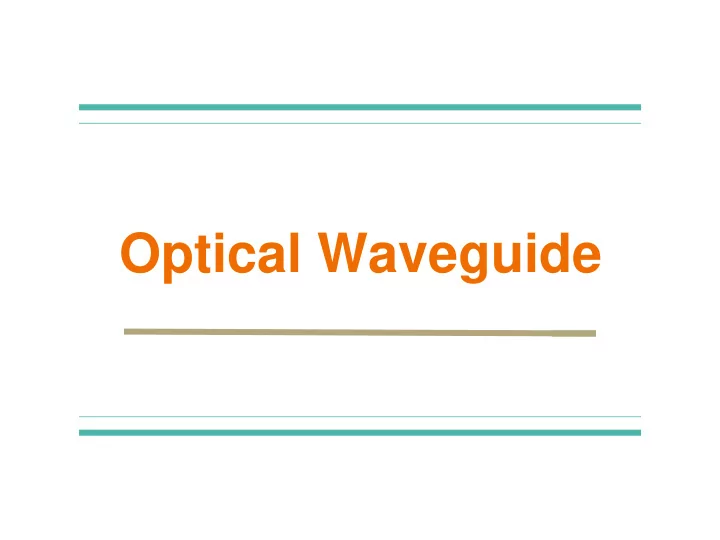

Optical Waveguide
Introduction ● Existing technology ○ Much existing research has been done on silicon waveguides ○ Optical fibre is an example of silicon waveguide technology ● Problem Transparency of silicon lies below 8µm ○ Germanium with a transparency range of 1.6µm to 18µm is more suitable ○
Objective Determine the cut off dimensions of Single-mode Germanium on Silicon optical planar waveguide in mid-IR region
Total Internal Reflection ● For total internal reflection to occur, the propagating wave must be travelling in a medium of higher refractive index and hit a boundary with a lower refractive index . ● If angle of incidence > critical angle, total internal reflection will occur The critical angle can be derived by equating the angle of refraction to be 90. 𝑜 1 𝑡𝑗𝑜𝜄 𝑗 = 𝑜 2 𝑡𝑗𝑜𝜄 𝑠 𝑡𝑗𝑜𝜄 𝑗 = 𝑜 2 𝑡𝑗𝑜𝜄 𝑠 𝑜 1
Methodology ● Ran simulations with the software MODE Solutions by Lumerical
Parameters ● Wavelength of source: 3.8 µm Apart from the wavelength falling in the Mid-IR region, the actual laser source that is used in the lab now is a 3.8 µm laser. ● Germanium core ○ Transparency: 1.6 µm to 18 µm, suitable in the mid-IR region (2-20 µm). Refractive index of 4.03, higher than the silicon cladding with refractive ○ index of 3.42. Higher electron mobility at 3900 cm 2 V −1 s −1 compared to silicon’s ○ 1400 cm 2 V −1 s −1
Parameters ● Initial dimensions of germanium core: x span = 50 µm, y span = 2 µm, z span = 1.5 µm ○ ● Dimensions of substrate: ○ x span = 50 µm, y span = 50 µm, z span = 10 µm
Methodology ● Obtain the modal analysis for the first four modes. Modes 1&2 (TE 0 , TM 0 ) – Single Mode propagation ○ Modes 3&4 (TE 1 , TM 1 ) – Dual Mode propagation ○ ● Sweep the y and z span Obtain graph with y axis as effective refractive index and x axis as the y ○ span and z span in two separate graphs ● Determine the dimensions with the sweep results
Results
Results ● Modal analysis ● Ensure that first 2 modes are single mode, next 2 are dual Mode 1 Mode 2
Results Mode 3 Mode 4
Results ● Vary the y- and z-spans ● Obtain effective refractive index, neff , from the simulation ● Calculate cutoff dimension where neff > nSi
Results 3.42 Z-span Y-span
Results 3.42 3.42 Z-span
Results ● Cut-off dimensions obtained: 50µm by 2µm by 0.6µm ● Zhang.H. previously obtained values of 2 μ m and 1.38 μ m (y and z) ● Our results differ by 0.78 μ m in the z-span ● Accounts for Zhang’s high transmission loss ● Reduced loss
Conclusion
Conclusion ● Germanium has many applications in chemical sensing and environment monitoring ● We found out the cutoff dimensions for a single-mode Ge waveguide
Further Applications ● Detection of specific chemicals ● Optimising the waveguide dimensions to reduce loss
Recommend
More recommend